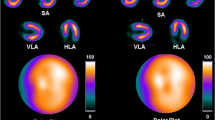Abstract
Background
Filtered back-projection (FBP) has been a standard in SPECT imaging. Newer iterative reconstruction algorithms have been shown to improve image quality and shorten acquisition time by taking into account statistical nature of raw data and using resolution recovery (RR). Wide-beam reconstruction (WBR) is an iterative algorithm with RR and adaptive noise control. We prospectively investigated outcome of WBR half-time SPECT on diagnostic certainty, accuracy and normalcy by quantitative perfusion analysis in comparison to full-time FBP images.
Methods
434 patients underwent rest 201Tl/stress 99mTc-sestamibi full-time (20 s/stop, FBP) followed by a half-time (10 s/stop, WBR) SPECT. 34 patients underwent an angiogram within 90 days of SPECT. Diagnostic certainty was based on summed stress scores (SSS, 5-point/17 segments): normal if SSS ≤ 1, equivocal if SSS = 2-3, and abnormal if SSS ≥ 4. Perfusion defects were normalized to a percent of total myocardium, and expressed as %LV = defect SSS/maximal SSS × 100% with maximal SSS of 28 for left anterior descending (LAD), and of 20 for right coronary (RCA) and left circumflex (LCX). Change in %LV (Δ%LV = %LV FBP − %LV WBR) was evaluated for diagnostically discordant versus concordant scans.
Results
SSS and %LV demonstrated very good correlation. There were significantly fewer equivocal scans with WBR (38 vs 151 FBP, P < .0001). Most discordant scans were equivocal FBP SPECT becoming normal with WBR (123/151). Δ%LVLAD for discordant studies was greater for women (5.4% ± 4.2%, P < .001), while Δ%LVRCA,LCX (4.4% ± 5.1%, P < .001; 1.2% ± 5.0%, P = .04) were greater for men. Normalcy rate was 91.4% for FBP and WBR with more definitely normal WBR studies (84.5% vs 43.9% for FBP, P < .0001). There were no differences in sensitivity (FBP 84.2%, WBR 81.6%), specificity (FBP 54.6%, WBR 63.6%), and accuracy (FBP, WBR 77.6%).
Conclusion
Quantitative perfusion analysis suggests that adaptive noise control with WBR improves uniformity of myocardium comparing to FBP techniques, and results in improved diagnostic certainty while preserving normalcy and accuracy.






Similar content being viewed by others
References
Bonow RO. 2009 ASNC keynote lecture: Measuring cost, cost-effectiveness and quality in cardiovascular imaging. J Nucl Cardiol 2010;17:362–9.
Borges-Neto S, Pagnanelli RA, Shaw LK, et al. Clinical results of a novel wide beam reconstruction method for shortening scan time of Tc-99m cardiac SPECT perfusion studies. J Nucl Cardiol 2007;14:555-65.
DePuey EG, Gadiraju R, Clark J, Thompson L, Anstett F, Shwartz SC. Ordered subset expectation maximization and wide beam reconstruction “half-time” gated myocardial perfusion SPECT functional imaging: A comparison to “full-time” filtered backprojection. J Nucl Cardiol 2008;15:547-63.
DePuey EG, Bommireddipalli S, Clark J, Thompson L, Srour Y. Wide beam reconstruction “quarter-time” gated myocardial perfusion SPECT functional imaging: A comparison to “full-time” ordered subset expectation maximum. J Nucl Cardiol 2009;16:736-52.
UltraSPECT Research and Development Team H, Israel. Wide-Beam Reconstruction: Technology and Applications White Paper. 2009.
Gibbons RJ, Balady GJ, Bricker JT, et al. ACC/AHA 2002 guideline update for exercise testing: Summary article: A report of the American College of Cardiology/American Heart Association Task Force on Practice Guidelines (Committee to Update the 1997 Exercise Testing Guidelines). Circulation 2002;106:1883-92.
Henzlova MJ, Cerqueira MD, Mahmarian JJ, Yao S-S. Stress protocols and tracers. J Nucl Cardiol 2006;13:e80-90.
Hachamovitch R, Berman DS, Shaw LJ, et al. Incremental prognostic value of myocardial perfusion single photon emission computed tomography for the prediction of cardiac death: Differential stratification for risk of cardiac death and myocardial infarction. Circulation 1998;97:535-43.
Cerqueira MD, Weissman NJ, Dilsizian V, et al. Standardized myocardial segmentation and nomenclature for tomographic imaging of the heart: A statement for healthcare professionals from the Cardiac Imaging Committee of the Council on Clinical Cardiology of the American Heart Association. J Nucl Cardiol 2002;9:240-5.
Berman DS, Kang X, Gransar H, et al. Quantitative assessment of myocardial perfusion abnormality on SPECT myocardial perfusion imaging is more reproducible than expert visual analysis. J Nucl Cardiol 2009;16:45-53.
Hachamovitch R, Hayes SW, Friedman JD, Cohen I, Berman DS. Comparison of the short-term survival benefit associated with revascularization compared with medical therapy in patients with no prior coronary artery disease undergoing stress myocardial perfusion single photon emission computed tomography. Circulation 2003;107:2900-7.
Venero CV, Heller GV. A multicenter evaluation of a new post-processing method with depth-dependent collimator resolution applied to full-time and half-time acquisitions without and with simultaneously acquired attenuation correction. J Nucl Cardiol 2009;16:714-25.
Bateman TM, Heller GV, et al. Multicenter investigation comparing a highly efficient half-time stress-only attenuation correction approach against standard rest-stress Tc-99m SPECT imaging. J Nucl Cardiol 2009;16:726-35.
Ficaro E, Krizman JN, Corbett JR. Effect of reconstruction parameters and acquisition times on myocardialperfusion distribution in normals. J Nucl Cardiol. 2008;15:S20.
Acknowledgment
We are thankful to Michael Wilk, Ph.D. for editorial assistance in clarifying the physics of WBR algorithm.
Disclosures
Regina S. Druz, MD has received a travel grant from UltraSPECT, Ltd. The other authors have nothing to disclose.
Author information
Authors and Affiliations
Corresponding author
Rights and permissions
About this article
Cite this article
Druz, R.S., Phillips, L.M., Chugkowski, M. et al. Wide-beam reconstruction half-time SPECT improves diagnostic certainty and preserves normalcy and accuracy: A quantitative perfusion analysis. J. Nucl. Cardiol. 18, 52–61 (2011). https://doi.org/10.1007/s12350-010-9304-5
Received:
Accepted:
Published:
Issue Date:
DOI: https://doi.org/10.1007/s12350-010-9304-5




